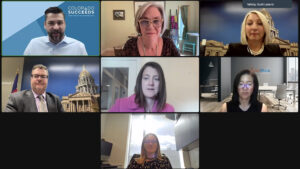A newly formed coalition of business organizations issued a report Wednesday calling for employers and educational leaders to work in closer collaboration to reduce the shortages of skilled talent plaguing companies across the state.
In its report, the Education to Employment Alliance noted the portion of Colorado students seeking a degree or certificate beyond high school fell to less than 50% in 2021, even as the state has found 91.4% of jobs that pay family-sustaining wages need an advanced certification. And it noted that while there continue to be about 200,000 available jobs in the state — roughly two for every out-of-work Coloradan — there have remained about 90,000 unemployed state residents throughout the year, speaking to the mismatch between needed and available skills.
To try to improve the state’s workforce-development pipeline, the five members of the alliance — the Colorado Chamber of Commerce, Colorado Inclusive Economy, Colorado Succeeds, the Colorado Technology Association and Colorado Thrives — outlined five recommendations. And while the recommendations deal with topics ranging from better measurements of student outcomes to financial aid for private-sector apprenticeships, they focus on the high-level themes that better coordination is needed between schools and workplaces, more support is needed for smaller businesses and evolving training pathways need greater priority.
“Our research and data collection continues to show that workforce is very much a top issue for employers, and there are roadblocks that continue to hold back businesses and potential workers,” Colorado Chamber President/CEO Loren Furman said at a news conference unveiling the coalition and report. “We believe there’s an urgency in addressing these issues now, and we can’t be complacent.”
How the report came about
That urgency comes after alliance members spent the past six months meeting with businesses, surveying members about workforce-development concerns and talking with higher-education leaders about existing programs. The idea is that by aligning students’ talents to skills that are in demand in the marketplace, students could be better prepared to enter sustainable careers and employers would not have to delay or nix job-creating expansions, as many have done in recent years.
The talent shortage is particularly acute among middle-skills jobs — those positions that require education beyond a high-school diploma but less than a bachelor’s degree, often in the form of certification or two-year associate degrees. While some analysts estimate that roughly half of the jobs in the state need middle-skills workers, only 15% of working-age Coloradans own credentials between a high-school diploma and bachelor’s degree.
“We need to provide individuals with the critical mid-level skills that our employer partners are asking for,” said Helen Young Hayes, founder of Colorado Inclusive Economy and CEO of ActivateWork, which trains individuals in technology skills and links them with employers. “The proposals offered today by the Education to Employment Alliance really support and expand the work of Colorado Inclusive Economy.”

The Education to Employment Alliance team that produced Wednesday’s report includes (clockwise from top left): Colorado Succeeds President Scott Laband; Colorado Technology Association President/CEO Frannie Matthews; Colorado Chamber of Commerce President/CEO Loren Furman; Colorado Inclusive Economy founder Helen Young Hayes; Colorado Thrives Executive Director Erin Trapp; Colorado Succeeds Vice President of Policy Katie Zaback; and Colorado Chamber of Commerce Vice President of Strategic Initiatives Ed Sealover.
Suggestions to improve workforce development
The five recommendations offered in the report are:
- Measure outcomes and direct funding to education and training programs that help graduates achieve sustainable careers.
While the Colorado Department of Higher Education has done significant work on collecting data to measure the post-graduate success of students, the data needs to be put into a form where it can be used more effectively by schools and students. Such data should also be able to compare traditional educational institutions with increasingly popular workforce-training programs as well, and it should be used to ensure funding goes to programs generating the greatest return on students’ investment.
- Create regional talent-development goals and action plans overseen by a workforce intermediary.
With a growing disconnect between educational and business leaders, the state should organize regional talent-development summits in which employers, educators and state government sit down at the same table, determine where the greatest shortfalls of skilled talent exist and craft plans to develop career pathways that address those shortfalls. The report recommends creation of an independent workforce intermediary, possibly funded via a public-private partnership, to monitor progress and be accountable to both employers and educators.
- Realign the pathways offered in schools with the needs of employers.
A prime way to address the shortage of middle-skills workers is to invest more in school-district innovation centers and regional industry hubs offering training in trades and other in-demand career pathways that are aligned with the needs of area businesses. Concurrent with this, businesses must help to affect cultural change by offering students glimpses of careers in middle-skills professions through participation in school career events, development of career-specific criteria and offering of instructors to help schools teach these needed skills.

Two engineers work together on a desktop computer.
- Streamline and incentivize employer participation in career-connected learning opportunities.
Small- and medium-sized businesses too often lack the financial or administrative resources to offer apprenticeships or internships; incentives and grants to local organizations to serve as intermediaries between schools and employers in setting up such opportunities would help. But the report also asks the state to simplify the process of applying for existing upskilling grants, and it asks it to re-examine labor laws involving minors that could inhibit high-school students from participating in supervised apprenticeships or internships.
- Ensure education providers are focusing on the skills that students and employers need.
Too many employers feel new graduates aren’t armed with job-specific skills, and the report recommends formation of statewide advisory boards for all career-focused majors that would let employers talk with higher-ed leaders about what is needed to succeed in professions. Also, the report calls for business to work with colleges in creating durable or “soft” skills rubrics that determine needed skills from communication to teamwork to problem-solving — and to work those into classes at the K-12 and collegiate levels.
What’s next
Alliance members plan to begin talking with education and state leaders in more depth about the goals on which they may align and figuring out what needs to be put into place to achieve those goals. Also, the five-member alliance expects to expand in the coming months as more businesses and business groups express interest in pushing for improvements to the workforce-development system.
“I think ultimately, what you can say is we envision a learner-centered talent-development system that’s going to respond to the dynamically changing needs of our businesses, our economy, our learners, our communities and our job seekers,” Colorado Succeeds President Scott Laband said.
